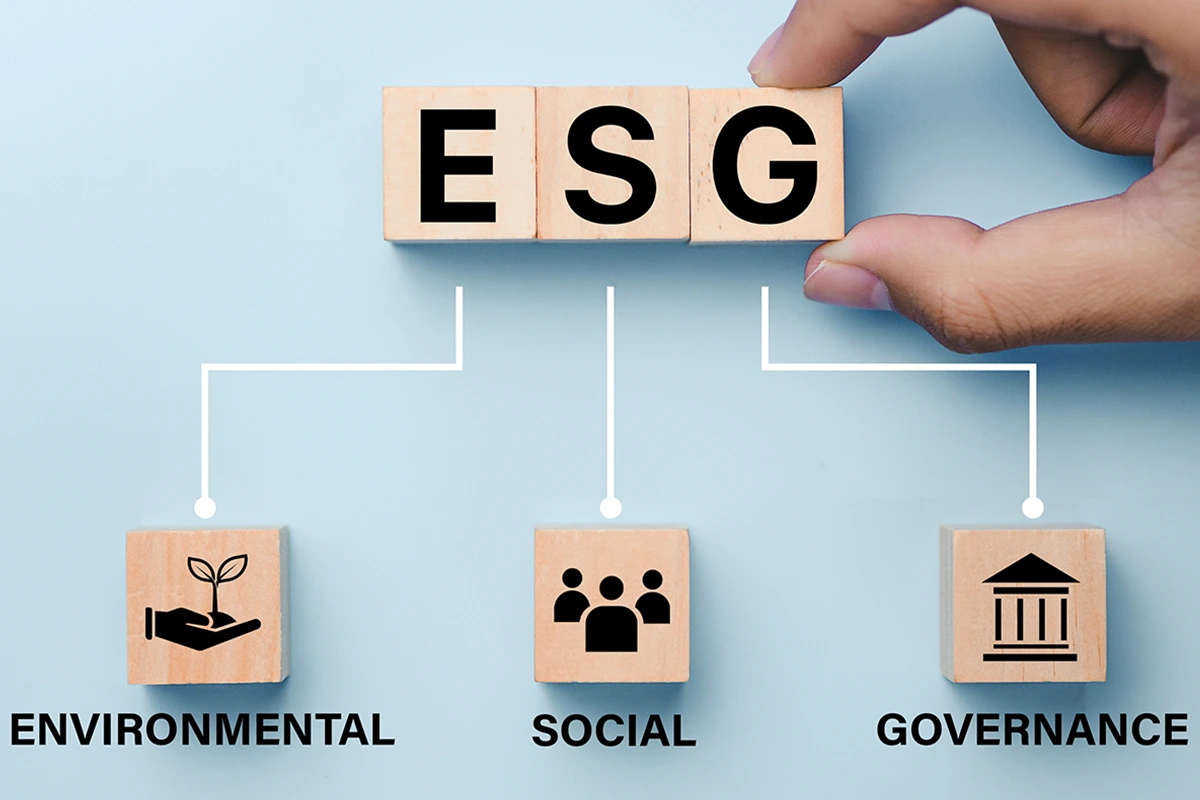Contents
Mastering ESG Metrics: A Comprehensive Guide for Businesses
21 December 2023 - Evotix
The correlation between effective environmental, social and governance (ESG) practices and positive corporate impact and performance is evident. However, leaders and managers at organizations worldwide are still in the process of familiarizing themselves with the operational aspects of ESG metrics management and propelling ESG initiatives forward. Giving precedence to ESG not only fosters support from stakeholders and communities but also serves to minimize fines, risks and penalties.
Some industry analysts have reported a correlation between higher equity returns and better ESG performance. As EY reported, nearly 70 percent of 500 global companies taking robust climate action improved their financial gains more than anticipated because of their ESG efforts.
ESG-related assets under management are projected to jump from over $18 trillion as of 2021 to nearly $34 trillion by 2026. Additionally, most senior executives—97 percent—say external stakeholders have a key influence on a company’s ESG reporting and disclosure policy. Therefore, ESG metrics management has become increasingly important for organizations, stakeholders and regulators. Identifying metrics that matter most to businesses is now a top priority.
What are ESG metrics?
An ESG metric is a measure of ESG factors. These factors can include carbon emissions, energy use, community impact and more. However, ESG metrics can also extend beyond these parameters to include performance indicators related to environmental, health, safety and sustainability (EHS&S) practices.
For example, a business enterprise will measure its waste management process, emissions goals or health and safety goals in relation to ESG performance. However, to achieve effective ESG metrics management, you first need to confirm you have the right processes in place to obtain quality data that supports disclosure and reporting. ESG data will receive the same scrutiny as financial data, and therefore should be auditable and of good quality.
Investors and regulators are increasingly seeking transparency and reliability in data. Failing to establish accurate processes and reliable data can lead to the pitfalls of greenwashing, potentially tarnishing a business's reputation. It's not just beneficial but imperative to have well-defined ESG processes and reliable data in place. Capturing high-quality data not only ensures transparency but also provides an accurate snapshot of risks.
Why are ESG metrics important?
ESG metrics play a pivotal role in helping companies become and remain compliant while fostering transparency into their overall performance. Beyond compliance, these metrics assist companies in pinpointing and rectifying gaps related to diversity, regulatory adherence, safety protocols, environmental considerations and more.
Consider a company looking to reduce its carbon footprint by half within five years. Achieving this ambitious goal requires the establishment of robust ESG metrics, providing a roadmap for success within the given timeframe. Regardless of industry or sector, companies universally benefit from comprehending, analyzing and acting upon ESG metrics. This strategic approach empowers them to distinctly outline priorities, identifying the key metrics that matter most.
Successful management of these vital metrics and timely data collection not only aids in achieving internal goals but also enhances responses to questionnaires from prominent ESG rating providers such as the Carbon Disclosure Project (CDP). In essence, aligning with the right metrics enables companies to navigate and respond effectively to the evolving landscape of ESG expectations.
How do you identify correct ESG metrics?
The metrics an organization chooses to collect and measure is closely tied to its industry segment. ESG standards and frameworks, often industry specific, also help provide valuable guidance about which metrics to collect. With the Global Reporting Initiative (GRI) framework, companies can aggregate and interpret data to make sure their goals are in sync with investors’ projections and expectations of what a company needs to report on. When organizations make information public about their ongoing impacts and contributions, this helps increase awareness for stakeholders, analysts, reporters and policymakers.
The Sustainability Accounting Standards Board’s (SASB) ESG guidance framework introduces industry-specific and sector-specific standards, providing companies with a structured approach to disclosing crucial information about their financial and sustainability-related material to investors.
Engaging in a comprehensive materiality assessment is a crucial step in identifying significant metrics. The focus should extend beyond immediate business materiality, encompassing a forward-looking perspective that anticipates the future trajectory of the business and upcoming regulatory changes. For instance, the Corporate Sustainability Reporting Directive (CSRD) mandates full reporting by the year 2024, emphasizing the importance of early identification and alignment with the correct ESG metrics.
Choosing which metrics to manage requires thoughtful consideration, and applicability assessments offer valuable insights. For instance, evaluating the impact of data protection laws at local, national and international levels aids in better determining risk mitigation needs in alignment with industry standards and pertinent privacy regulations. This proactive approach ensures that businesses are well-prepared for evolving compliance and reporting requirements.
How do metrics vary by industry?
Here is just a small sampling of what metrics management looks like for three different industries – construction, manufacturing and healthcare.
1. Construction – Key ESG standards for the construction industry include GRI for comprehensive disclosures and risk management, and MSCI ESG Focus Indexes Methodology for understanding ESG metrics. Notable ESG metrics for construction encompass carbon footprint, waste generation, sustainable materials usage, worker safety and responsible land use. The International Sustainability Standards Board (ISSB) is set to introduce global industry-specific standards, while the Sustainability Accounting Standards Board (SASB) already covers 77 industries. Governance metrics assess board diversity, regulatory compliance and ethical standards. Scope 1 (purchased fuels), Scope 2 (purchased electricity) and Scope 3 (staff and product transportation, business travel) are crucial considerations in this industry.
2. Manufacturing – The manufacturing industry contributes to environmental disruption. Some ESG metrics include water usage, community engagement, greenhouse gas emissions and sustainability in production practices. Tracking metrics like recycled aluminum volume, coil performance and gas consumption remains critical.
3. Healthcare – In the healthcare industry, key ESG metrics encompass patient satisfaction, executive compensation, waste management, service distribution, care quality, patient access and regulatory compliance. Transparency and addressing racial inequities are critical, along with optimizing operational efficiency in areas such as travel and electricity. Reporting opportunities include steps to reduce carbon footprint and the positive health impacts of creating green spaces.
Due to ESG regulations, organizations may eventually value metrics management the same way they do financial data.
One of many regulations, for example, is the CSRD. This is EU legislation mandating companies publish ongoing reports about their environmental and social impact efforts to drive more sustainable corporate approaches and impacts. The CSRD’s wide-scale single set of reporting standards may up the quality of non-financial data. This means in the future, ESG disclosures may align more closely than they do now with financial accounting and reporting data.
Where does data come into play?
Data must be centralized and accessible, yet unfortunately, many organizations still fail to operate in this way. Organizations often face challenges with decentralized ESG metrics, stored in disparate spreadsheets or non-digitized silos, hindering transparency and accessibility. This proves problematic when regulators or investors demand specific data tied to quality standards. Lacking the right data infrastructure may lead to rushed or manipulated reporting, increasing the risk of audit discrepancies.
To overcome these hurdles, a robust EHS&S program serves as a foundational solution, ensuring efficient, cost-effective data gathering for streamlined ESG metrics management. This includes crucial data points like carbon footprints, energy consumption, water conservation and diversity, equity and inclusion (DEI) initiatives. Embracing technology becomes imperative for a seamless, automated approach that fosters trust and transparency in reporting.
How does technology facilitate ESG strategy?
After your data has been collected, tracked, measured and reported, it is necessary to conduct numerous next steps, including:
-
Automating data collection and calculations
-
Measuring ESG sustainability and performance
-
Disclosing reporting with confidence
-
Responding to evolving requirements with ease and agility
Technology is an important facilitator. A robust, automated EHS&S program can guarantee a streamlined process through efficient, cost-effective data gathering that can support ESG metrics management and disclosure reporting—with the transparency and trust needed.
This includes data related to carbon footprint, energy consumption, water conservation, diversity, equity and inclusion (DEI) initiatives and more. ESG mandates are anchored on relevancy, accuracy and transparency of information. Any untrustworthy disclosure or omission can undermine confidence with stakeholders and investors. Organizations with manual and paper-driven processes often end up with unreliable data that can negatively impact ESG performance and disclosure reporting.
Technology fosters effective processes and visibility of the supply chain ecosystem and an organization’s health and safety initiatives. Technology does not just enable data collection; it also allows you to define measurable ESG goals and bring the entire organization along with you to achieve ESG objectives together.
Achieving effective end-to-end ESG metrics management necessitates a comprehensive approach encompassing the identification of pertinent metrics, robust data collection methods, thorough analysis and transparent reporting through intuitive dashboards. This cohesive process not only facilitates internal understanding of targets and goals but also establishes clear connections to overarching business objectives. Embracing this holistic framework ensures that organizations can navigate the complexities of ESG metrics with efficiency and precision, fostering a culture of sustainability and responsible business practices.
Interested in learning more about how the CSRD will impact organization’s ESG reporting moving forward? Check out our blog: CSRD and the Future of ESG Disclosure: Empowering European Corporations
RELATED BLOGS

An Overview of CSRD Reporting Requirements and Framework
27 February 2025 - Evotix
Introduced in 2022 by the European Commission, the Corporate Sustainability Reporting Directive (CSRD) aims to expand the scope of sustainability disclosure for the European Union (EU). The CSRD is..

Understanding the CSRD Reporting Timeline
20 March 2025 - Evotix
On July 31, 2023, The European Commission (EC) made a significant stride toward fulfilling the goals of the European Green Deal by officially embracing the European Sustainability Reporting Standards..

What is ESG?
4 August 2022 - Matthew Elson
Environment, Social and Governance (ESG) has become the de facto standard by which companies are assessed by financial institutions and investors on their management of risk and opportunities on..
